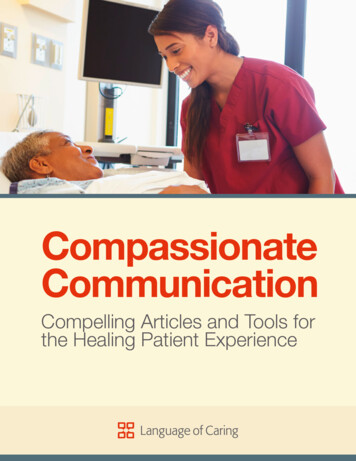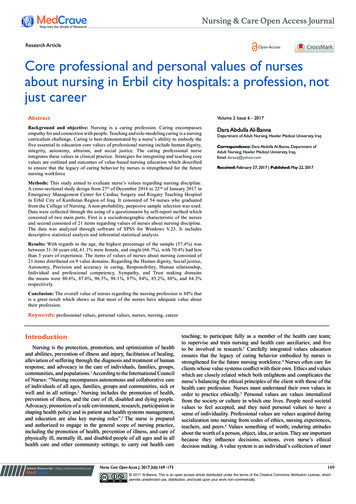
Transcription
Supporting and empowering youCaring for a person witha stoma:A practical guide for staff in nursing andresidential homes and for home carerswww.ColostomyUK.orgStoma helpline:0800 328 4257
Caring for a person with a stomaColostomy UKWe are Colostomy UK. Here if you have questions, need support or just want to talkto someone who lives with a stoma.Your voice on the bigger issues: advocates for your rights and campaigning to raiseawareness of what matters to you; running projects to empower you; buildingcommunities to support you.Contact usWrite to:Colostomy UKEnterprise House95 London StreetReadingBerkshireRG1 4QAAdminline:Tel: 0118 939 1537Stoma helpline:0800 328 omyUK.org2www.ColostomyUK.org
ContentsIntroduction4What is a stoma?4Why do people have stoma surgery?4Three main types of stoma6Caring for a person with a stoma7Stoma Bags7How to change a bag8Day-to-day life with a stoma10Common problems and concerns11Patient worries and concerns: physical and mental wellbeing14Further help:17Supporting and empowering you3
Caring for a person with a stomaIntroductionThis publication is relevant to anyone who has the responsibility of caring fora person with a stoma. People with stomas are often known collectively as‘ostomates’. We use this term throughout. After briefly describing what a stomais and why people have stoma surgery, the booklet goes on to cover the practicalaspects of caring for someone with one. This includes everything from orderingtheir medical supplies and disposing of waste, to diet, changing a person’s stomabag and recognising some of the common problems ostomates suffer, such assore skin. Consideration is then given to the worries and concerns that people withstomas have and how these can impact on their physical and mental wellbeing.What is a stoma?A stoma is a surgically created opening on the surface of the abdomen. In mostcases the procedure involves the removal of a damaged or diseased part of thelarge intestine. The healthy part of the intestine is then brought out through theabdomen, allowing bodily waste to be collected in a bag or pouch.Why do people have stomasurgery?People of all ages and sexes have stoma surgery. This is because it is used in thetreatment of many different illnesses and conditions. These include: cancer,inflammatory bowel disease (eg ulcerative colitis, Crohn’s diseases etc), diverticulardisease, new–born malformations, incontinence (arising from, for example childbirth), chronic constipation, trauma (which causes damage to the bowel). Somepeople’s stomas are permanent, others have temporary stomas which are laterreversed.4www.ColostomyUK.org
Supporting and empowering you5
Caring for a person with a stomaThree main types of stomaThere are three main types of stoma:ColostomyThis is the term used to describe an opening from the colon or largeintestine. The stoma is usually sited on the left side of the abdomen. Theoutput from a colostomy differs from person to person, but tends to be moresolid and often resembles a ‘normal’ stool. A colostomy commonly functionsbetween one and three times a day.IleostomyThis is the term used to describe an opening from the ileum or smallintestine. Typically it is sited on the right of the abdomen. An ileostomy ismore active than a colostomy, functioning three to six times a day and theoutput is looser.UrostomyThis is the term used to describe a stoma for a person’s urine. It is alsosometimes referred to as an ileal conduit. A urostomy is formed by taking apiece of the patient’s small intestine and attaching the ureters to it, forminga passageway for urine to pass through. One end of the tube is brought outthrough the abdomen to create the urostomy. Usually the person’s bladderis removed too. A urostomy is normally on the right side of the abdomen.Unlike a colostomy or an ileostomy, a urostomy functions all the time.What does a stoma lookand feel like?A stoma looks a bit like the inside of your mouth. It is soft to the touch, pinkish–redin colour and should be moist. When a person first has stoma surgery, it is normalfor their stoma to be swollen. It can take a couple of months to reduce in size.6www.ColostomyUK.org
Caring for a person with a stomaStoma bagsThere are five main types of stoma bag. Each type is made by a number of differentmanufacturers. The bag an ostomate uses is determined by the type of stoma theyhave and also by what they feel most comfortable wearing and most confidentchanging. The importance of the latter should not be underestimated. One–piece bag: has an adhesive flange which is attached directly to theskin. After use the bag is disposed of and a new one fitted. Two–piece bag: consists of an adhesive baseplate which is fitted around thestoma and then the bag either sticks or is clipped to this. Once used, the bagis removed and disposed of, and a fresh bag attached to the baseplate. Thebaseplate is designed to remain attached to the skin for several days.Bag pictures used by kind permission of Salts Healthcare Closed bag: are mainly for formed motions. They are more commonly usedby people with colostomies. They are usually changed several times a day.Some closed bags have a special liner which contains the motions and canbe flushed down the toilet. Drainable bag: are mainly for more liquid motions. They are commonly used bypeople with ileostomies. They can be worn for longer than closed bags as theycan be emptied through an outlet at the bottom of the bag and then resealed. Urostomy bag: are for collecting urine. They are worn by people who havehad a urostomy. A urostomy bag is drainable and has a tap at the bottom.One–piececlosed stoma bagOne–piecedrainable stoma bagSupporting and empowering youTwo–piece closed stoma bagand flange7
Caring for a person with a stomaHow to change a bagGetting readyMake sure that you have everything you need to hand before you start (adhesiveremover, new bag, baseplate, disposal sack, curved scissors, warm water and atowel). A stoma bag is best changed when it is about three–quarters full. Wherepossible, it is sensible to do changes in the bathroom. A bag can be changedwhen the ostomate is sitting down but, sitting down can cause the skin to creaseand fold, making it trickier to get a good seal between the skin and the baseplateor adhesive flange. Thus, if the ostomate is able to stand for bag changing, thisis often preferable. Alternatively, if this is not possible, then changing could becarried out with them lying flat on a bed.Step one: the templateBegin by checking whether the hole in the adhesive flange/baseplate hasbeen pre–cut to the size and shape of the ostomate’s stoma. Pre-cuttingis something offered by most suppliers of stoma bags. If it has not beenpre–cut use a template to mark the outline of the stoma and, using curvedscissors, trim to the correct shape. Getting this right is important. If the holeis too large, then the skin around the stoma will become sore and irritatedthrough contact with the bag’s contents. If the hole is too small, then it mayrub against the stoma, causing it to swell.Fig. 1: CorrectFig. 2: IncorrectStep two: remove the used flange/baseplate and/or bagStart by spraying adhesive remover (if required) sparingly along the topedge of the flange or baseplate. Then, remove by peeling away from theskin, top to bottom. As you do this, you should support the skin with yourfinger. Gently clean the stoma and surrounding skin with warm water and8www.ColostomyUK.org
dry it thoroughly. You should pat dry, rather than rubbing dry. Check the skinaround the stoma for any early signs of soreness or irritation. Do not usesoaps or baby wipes as these often contain perfume or moisturisers, whichcan irritate the skin. They can also adversely affect the adhesion of the newflange or baseplate.Step three: apply new flange/baseplate and/or bagStick the lower half of the flange or baseplate beneath the stoma and thenroll it up and over the stoma. Hold in place for at least 30 seconds to makesure that the seal is secure. If the patient is using a two–piece appliance,then attach the bag to the base plate.Step four: disposal of used bagsSeal the used bag and used flange/baseplate in a disposal bag. These areoften provided free by suppliers. A nappy disposal bag is also suitable. In anursing or care home, this can then be disposed of with other clinical waste.Outside of the nursing or care home setting it is advisable to check if yourlocal authority operates a clinical waste collection service. If this service isnot available in your area, the used bag and contents can be treated in thesame way as a nappy: wrapped up well and put in the dustbin. Prior to doingthis, consideration should be given to disposing of the bag contents in thetoilet.As was mentioned on page 7, some closed bags have a special liner whichcontains the motions and can be flushed down the toilet.Changing a stoma bagStep 2Step 3Supporting and empowering you9
Caring for a person with a stomaDay-to-day life with a stomaObtaining bags and related medical suppliesStoma bags and related medical supplies are obtained by prescription. Everyoneliving in the UK who has a permanent stoma is entitled to free prescriptions,whatever their age. However, those under the age of 60 will need to apply fora medical exemption certificate. Application is made using the form FP92A(obtainable from hospital or GP surgery).People with temporary stomas are not automatically entitled to free prescriptions(although they may qualify if their personal circumstances meet other criteria). Fullup–to–date details about prescriptions (including eligibility for free prescriptions)can be found at: stsIf the person you are caring for is not entitled to free prescriptions then it maybe cheaper to pay for a pre–payment certificate. Up–to–date information canbe found at: riptions can either be taken to a chemist or sent to a specialist supplier who willfulfil and deliver the order. This process is now often carried out electronically. Thestoma care nurse or GP will be able to advise you what system operates in your area.There are many suppliers and so it is worth recording their details and the productcodes of supplies in the space provided at the back of this booklet. Most suppliersalso offer a free template cutting service (see page 8). Again, the stoma care nurseor GP will be able to advise.DietIn most cases, people with stomas can quickly return to their usual eating anddrinking habits after surgery. Sometimes patients are given dietary advice to avoidcertain foods as they can cause watery stools or wind for example. But this is patientspecific. Generally speaking people with stomas, just like everyone else, should eata healthy and balanced diet, unless advised otherwise by a healthcare professional.10www.ColostomyUK.org
Colostomy UK’s booklet Healthy eating: Nutritional guidelines for people who have astoma provides more detailed information. This can be downloaded free from ourwebsite. Alternatively contact us and we will send you a copy.Bathing and showeringAn ostomate’s bag can be left in place or taken off while they are in the bath ortaking a shower. Water cannot get into the bag or the stoma. If the ostomateprefers to remove their bag, then it is a good idea to schedule baths and showersto coincide with times when the stoma is less likely to be active (eg before, ratherthan after a meal).Common problems and concernsListed below are some of the problems people with stomas experience. If you are inany doubt, you should always seek medical advice.DiarrhoeaIf a large section of the colon has been removed, or the colon removedentirely, it is likely that motions will always be fairly liquid. It may be easierto use a drainable bag. If motions are usually formed then an episode ofdiarrhoea could be due to a stomach upset, stress and/or emotional upsetor medication. If diarrhoea persists, then you should contact the stoma carenurse or GP.ConstipationLack of fruit and fibre in a person’s diet can lead to constipation, whichcan be caused by not drinking enough fluids. It can also be the side effectof medication. If a person’s stoma has not worked for several days orthere is any pain or vomiting then you should seek medical advice. Unlessprescribed by a doctor or stoma care nurse, you should not give an ostomatesuppositories or enemas.Supporting and empowering you11
Caring for a person with a stomaLeakageIt is not normal for stoma bags to leak. When they do, it is time to consultthe stoma care nurse. It may be that the size of the stoma has changed andthus requires measuring for a new template. Similarly, changes in a person’sweight and/or body shape can cause leakage. The stoma care nurse will beable to suggest alternative bags or accessories to resolve the problem.Sore skinIf the skin around the stoma becomes red and inflamed this can be due todamage caused to the skin when removing the flange/baseplate. Using anadhesive remover may help to prevent this. With a two–piece or drainablebag, the flange/baseplate remains in place for several days, which reducesdamage to the skin.Sore skin can also result from contact between the contents of the bagand the skin. Stomas can change in size and shape, so check the size of thestoma every few months to make sure the hole in the flange/baseplate fitssnugly around the stoma (see fig 1, page 8).If the problem persists, then it is time to consult a stoma care nurse.PancakingThis occurs when, instead of dropping to the bottom of the bag, the motioncollects around the stoma and may seep between the flange and the skin.One of the reasons for this happening is insufficient air in the bag, whichleads to the sides of the bag sticking together. It may help to cover the bag’sfilter with a sticky patch, to prevent gas escaping from the bag. Anothersolution is to add a small piece of crumpled tissue to the bag to keep thesides apart. Lubricating the inside of the bag with baby oil, or one of thespecial lubricants available from stoma suppliers can also help the motion todrop to the bottom of the bag.12www.ColostomyUK.org
BallooningThis occurs when gas expelled from the stoma collects inside the bag,causing it to inflate. Most bags have a filter on them, which allows gas toescape. Occasionally, this filter will become blocked, leading to ballooning.This can happen for example if the filter gets wet. Hence, when bathing it’sa good idea to cover the filter with a sticky patch (supplied with bags). Whenballooning occurs, it is a signal to change the bag. If ballooning occurs ona regular basis it may be worth trying a different bag (either type of bag ormanufacturer of bag, or both). The ostomate’s stoma care nurse will be ableto advise.BleedingA stoma can bleed if it is rubbed too hard. It is also likely to bleed more easily,if the ostomate is taking anticoagulant drugs (eg Warfarin or aspirin). If thestoma bleeds and does not stop, or the blood is coming from inside thestoma, you should consult a stoma care nurse, without delay.Rectal dischargeIt is normal for ostomates who still have their rectum in place to pass clearor putty–coloured mucus out through their anus. This occurs because thelining if the bowel produces mucus as a lubricant to assist the passageof food and waste. Even though motions will now pass out through thestoma, the rectum continues to produce mucus, although the amountmay decrease over time. You can read more in Colostomy UK’s booklet:Rectal discharge following stoma surgery. Download a copy from our website,alternatively e–mail: info@ColostomyUK.org or call us 0118 939 1537 andwe will send you one.Rectal discomfortAfter stoma surgery some ostomates still experience the sensation of rectalfullness and feel as if they need to pass a motion in the normal way. Sittingon the toilet and relaxing the muscles in this area may provide some relief.Other coping strategies and treatment options are discussed in ColostomyUK’s booklet: Pain and discomfort following stoma surgery. Download a copyfrom our website, alternatively e–mail: info@ColostomyUK.org or call us0118 939 1537 and we will send you one.Supporting and empowering you13
Caring for a person with a stomaPatient worries and concerns: physical andmental wellbeingIt is important to remember that when a person has stoma surgery it is usuallybecause they have been very unwell for some time. It is major surgery too, whichalters the way in which the patient’s body functions. In the post–operative period,ostomates often feel emotionally overwhelmed. It also takes them time to cometo terms with what they have been through. The amount of time this takesvaries from ostomate to ostomate. Some, never fully adjust to life with a stoma.Ostomates commonly worry about body image and how they ‘look’, even thoughtheir condition is ‘hidden’. Many also harbour concerns that they might ‘smell’ orthat their bag might leak. In extreme cases this can lead to isolation and problemswith mental health. In caring for a person with a stoma it is important to awareof these things and seek the help of a healthcare professional if you becomeconcerned.14www.ColostomyUK.org
Research shows that being physically and mentally active benefit a person’sphysical and mental wellbeing. Ostomates are no different. The central aim ofColostomy UK’s ‘Active Ostomates ’ initiative is to support the physical andmental wellbeing of ostomates. ‘Active Ostomates ’ is constantly developingand with each year that passes we add more activities, challenges and events.Some are delivered via support groups, such as Chair Yoga and our CreativeMinds Arts sessions. Others are things that people can do in the comfort of theirown home, such as the medically–approved exercises, which form part of ourbooklet: Active ostomates: Sport and fitness after stoma surgery. You can downloadthis resource, which won ‘highly commended’ at the British Medical AssociationPatient Information awards in 2017, from our website. Alternatively e–mail: info@ColostomyUK.org or call us 0118 939 1537 and we will send you one.To find out more about Active Ostomates and how the person you are caring formight get involved and benefit, we recommend you visit our website. This is theplace to find the most up–to–date information.Supporting and empowering you15
Caring for a person with a stomaOther considerations – DementiaCaring for an ostomate who develops dementia, or caring for a person withdementia who then goes on to have stoma surgery, can be challenging. It is for thisreason that Colostomy UK have partnered with Dementia UK to produce a bookletcalled: Caring for a person with a stoma and dementia. You can download a copy fromour website, alternatively e–mail: info@ColostomyUK.org or call us 0118 9391537 and we will sendCyouUK056 one.02v00r00 Caring for a person witha stoma and dementia.qxp CUK05602v00r00 12/06/2019Caringa stomafor a person withand dementiawww.ColostomyUK.orgStomahelpline:0800 328 425716www.ColostomyUK.org09:05Page 1
Further helpCare workshopsColostomy UK run workshops for professional carers and family carers. These aredelivered by healthcare professionals and expand on the many issues covered inthis booklet. Our care workshops and this booklet complement one another. Tofind out more please visit our website, e–mail: info@ColostomyUK.org or call us0118 939 1537.Signposts Carers UKInformation on benefits, rights and services available to carers.Website: www.carersuk.org CarerstrustProvide support for carers and the people they care for.Website: www.carers.orgSupporting and empowering you17
Caring for a person with a stomaSupport from Colostomy UKWe hope that you have found this booklet useful. There are lots of other ways inwhich we can help and support you:We provide: A stoma helpline: 0800 328 4257. Support literature and factsheets about all aspects of Living with a stoma. Tidings, a quarterly magazine full of the latest news, articles by healthcareprofessionals, product information and real–life stories from otherostomates. A private Facebook group for supporting each other and exchanging hintsand tips. A website that provides practical information, details of open days and adirectory of organisations, support groups, products and services.We also have over 100 volunteers that have or have had a stoma(s), so if you stillhave any concerns or questions please get in touch and we can arrange for one ofthem to contact you.18www.ColostomyUK.org
Patient Profile: An at a glance reference guide for carers and ostomatesName: (Mr/Mrs/Miss/Ms)Address:Postcode:NHS No:Date of Birth:Telephone No:Hospital/Outpatients attended:About the Stoma:Stoma Type: ColostomyIleostomyUrostomyStoma Size:(mm)Template: Yes/NoName/Type of supplyItem Code:Medical supplies used:Date:Manufacturer’s Name & Tel No:Supplier/Delivery Company:Date:Main Contacts:Colostomy UK:Name of SupplierTel No:Order Ref:24–hour stoma helpline: 0800 328 4257 Tel No: 0118 939 1537Stoma Nurse:Tel No:GP/Practice:Tel No:Consultant/Surgeon:Tel No:Pharmacist:Tel No:Medical Helplines:NHS Direct (England):www.nhsdirect.nhs.ukTel No: 111NHS Direct (Scotland):www.nhs24.comTel No: 111NHS Direct (Wales):www.nhsdirect.wales.nhs.ukTel No: 0845 4647Supporting and empowering you19
Colostomy UK’s flagship magazine Tidings, is hailed byostomates and healthcare professionals alike for thesupport and information that it provides readers withon a quarterly basis.Visit our website or call us to sign up for your free copy.How to contact usWrite to: Enterprise House, 95 London Street, Reading, Berkshire, RG1 4QAAdminline: 0118 939 1537Stoma helpline: 0800 328 4257E–mail: info@ColostomyUK.orgWebsite: www.ColostomyUK.orgCUK020 05v00r00Date of Publication: March 2020Copyright 2016‒2020 Colostomy UKRegistered charity no. 1113471
more active than a colostomy, functioning three to six times a day and the output is looser. Urostomy This is the term used to describe a stoma for a person's urine. It is also sometimes referred to as an ileal conduit. A urostomy is formed by taking a piece of the patient's small intestine and attaching the ureters to it, forming











